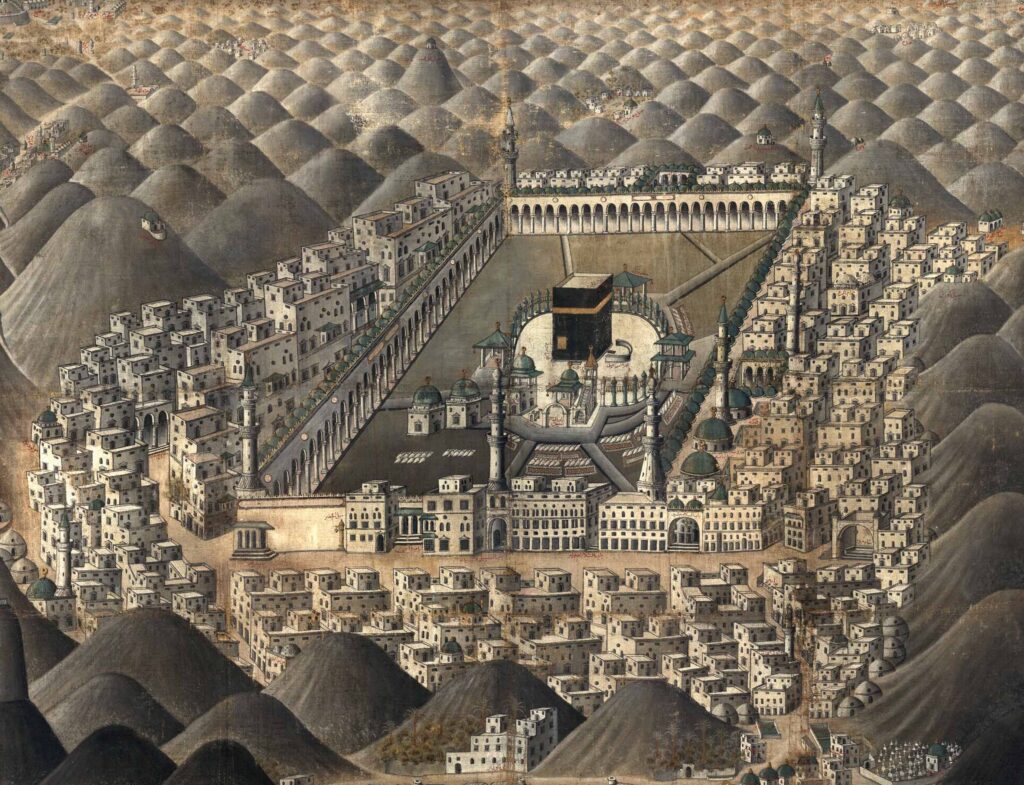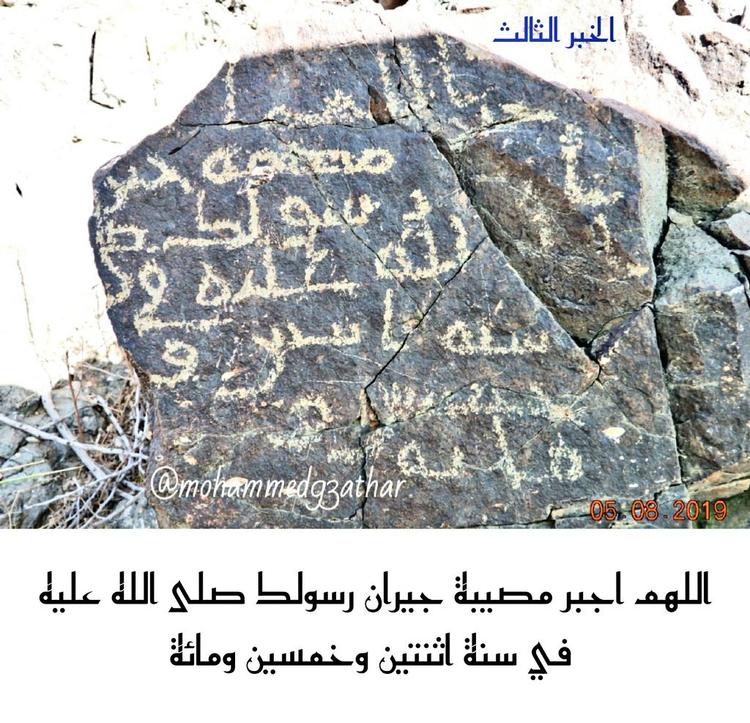
The Kaaba
The Kaaba, a shrine located near the center of the Grand Mosque in Mecca, is the most sacred place in the Muslim world. It is also called the “House of Allah.” Millions of Muslims throughout the world turn toward the Kaaba five times each day when they pray. In addition, Muslims bury their dead with their heads pointing toward the Kaaba.
The shrine is also the primary destination of Muslims during the hajj. Pilgrims visiting Mecca walk counterclockwise around the Kaaba seven times. This ritual imitates angels walking around God’s heavenly throne and symbolizes for the pilgrims their entry into the presence of God.
The Arabic word kaaba means “cube” and reflects the cube shape of the gray stone structure. The Kaaba measures about 33 feet wide, 50 feet long, and 45 feet high. Its corners coincide with the four points of the compass. The interior of the Kaaba is bare, except for three pillars supporting the roof and silver and gold lamps hanging from the ceiling. During most of the year, the Kaaba is covered with a woven black cloth called “kiswah,” that has verses from the Qur’an embroidered on it.
According to popular Muslim tradition, Adam built the Kaaba as a copy of the heavenly house of Allah. Its destruction during Noah’s Flood left only the foundation. The Qur’an says that Ibrahim (Abraham) and his son Ismail (Ishmael) built the shrine. By the time of Muhammad , however, the Kaaba had come under the control of the Quraysh, the major tribe of Mecca, and was used as a shrine for idols of their gods. In the year 630, when Muhammad triumphantly returned from exile to his native Mecca, he rid the Kaaba of its idols and restored the monotheistic religion of Abraham.
The Kaaba is believed by Muslims to have been rebuilt several times throughout history, most famously by Ibrahim (Abraham) and his son Ismail (Ishmael), when he returned to the valley of Mecca several years after leaving his wife Hajar (Hagar) and Ismail (Ishmael) there upon Allah’s command. Circling the Kaaba seven times counterclockwise, known as Tawaf, is an obligatory rite for the completion of the Hajj and Umrah pilgrimages. The area around the Kaaba on which pilgrims circumambulate is called the Mataaf.
The Kaaba and the Mataaf are surrounded by pilgrims every day of the Islamic year, except the 9th of Dhu al-Hijjah, known as the Day of Arafah, on which the cloth covering the structure, known as the Kiswah (‘Cloth’) is changed. However, the most significant increase in their numbers is during Ramadan and the hajj, when millions of pilgrims gather for tawaf. According to the Saudi Ministry of Hajj and Umrah, 6,791,100 pilgrims arrived for the Umrah pilgrimage in the Islamic year 1439 a 3.6 percent increase from the previous year, with 2,489,406 others arriving for the 1440 AH Hajj.
Origin
Prior to Islam throughout the Arabian Peninsula, the Kaaba was a holy site for the various Bedouin tribes of the area. Once every lunar year, the Bedouin tribes would make a pilgrimage to Mecca. Setting aside any tribal feuds, they would worship their gods in the Kaaba and trade with each other in the city. Various sculptures and paintings were held inside the Kaaba. A statue of Hubal (the principal idol of Mecca) and statues of other pagan deities are known to have been placed in or around the Kaaba. There were paintings of idols decorating the walls. A picture of ‘Isa and his mother Maryam was situated inside the Kaaba and later found by Muhammad after his conquest of Mecca. The iconography portrayed a seated Maryam with her child on her lap. The iconography in the Kaaba also included paintings of other prophets and angels. Undefined decorations, money and a pair of ram’s horns were recorded to be inside the Kaaba. The pair of ram’s horns were said to have belonged to the ram sacrificed by Ibrahim in place of his son Ismail as held by Islamic tradition.

The Kaaba, 1400 years ago.
In her book, Islam: A Short History, Karen Armstrong asserts that the Kaaba was officially dedicated to Hubal, a Nabatean deity, and contained 360 idols which probably represented the days of the year. However, by the time of Muhammad’s era, it seems that the Kaaba was venerated as the shrine of Allah, the High God. Once a year, tribes from all around the Arabian Peninsula, whether Christian or pagan, would converge on Mecca to perform the Hajj pilgrimage, marking mthe widespread conviction that Allah was the same deity worshipped by monotheists. Alfred Guillaume, in his translation of the Ibn Ishaq’ s “seera,” “sirah” or “sirat,” all meaning “life” or “journey,” says that the Kaaba itself might be referred to in the feminine form. It is disputed whether Allah and Hubal were the same deity or different. Per a hypothesis by Uri Rubin and Christian Robin, Hubal was only venerated by Quraysh and the Kaaba was first dedicated to Allah, a supreme god of individuals belonging to different tribes, while the pantheon of the gods of Quraysh was installed in Kaaba after they conquered Mecca a century before Muhammad’s time.

The Kaaba, 1721 – 300 years ago.
Others contends that there were numerous such Kaaba sanctuaries in Arabia at one time, but this was the only one built of stone. The others also allegedly had counterparts of the Black Stone. There was a “Red Stone,” in the Kaaba of the South Arabian city of Ghaiman; and the “White Stone” in the Kaaba of al-Abalat. Grunebaum in Classical Islam points out that the experience of divinity of that period was often associated with the fetishism of stones, mountains, special rock formations, or “trees of strange growth.” Armstrong further says that the Kaaba was thought to be at the center of the world, with the Gate of Heaven directly above it. The Kaaba marked the location where the sacred world intersected with the profane; the embedded Black Stone was a further symbol of this as a meteorite that had fallen from the sky and linked heaven and earth.

The Kaaba, 1880 – 150 years ago.
According to Sarwar, about 400 years before the birth of Muhammad, a man named ‘Amr bin Luhayy, who descended from Qahtan and was the king of Hijaz placed an idol of Hubal on the roof of the Kaaba. This idol was one of the chief deities of the ruling Quraysh tribe. The idol was made of red agate and shaped like a human, but with the right hand broken off and replaced with a golden hand. When the idol was moved inside the Kaaba, it had seven arrows in front of it, which were used for divination. To maintain peace among the perpetually warring tribes, Mecca was declared a sanctuary where no violence was allowed within 30 kilometres (20 mi) of the Kaaba. This combat-free zone allowed Mecca to thrive not only as a place of pilgrimage, but also as a trading center.
Many Muslim and academic historians stress the power and importance of the pre-Islamic Mecca. They depict it as a city grown rich on the proceeds of the spice trade. Crone believes that this is an exaggeration and that Mecca may only have been an outpost for trading with nomads for leather, cloth, and camel butter. Crone argues that if Mecca had been a well-known center of trade, it would have been mentioned by later authors such as Procopius, Nonnosus, or the Syrian church chroniclers writing in Syriac. The town is absent, however, from any known geographies or histories written in the three centuries before the rise of Islam. According to the Encyclopedia Britannica, “before the rise of Islam, it was revered as a sacred sanctuary and was a site of pilgrimage.” According to historian Eduard Glaser, the name “Kaaba” may have been related to the southern Arabian or Ethiopian word “mikrab,” signifying a temple. Again, Crone disputes this etymology.
In Samaritan literature, the Samaritan Book of the Secrets of Moses (Asatir) claims that “Ishmael and his eldest son, Nenaioth, built the Kaaba as well as the city of Mecca.” The Asatir book was likely compiled in the 10th century A.D. though Moses Gaster suggested in 1927 that it was written no later than the second half of the 3rd century B.C.
According To Islamic Opinion
The Qur’an contains several verses regarding the origin of the Kaaba. It states that the Kaaba was the first House of Worship for mankind, and that it was built by Ibrahim and Ismail on Allah’s instructions.
Verily, the first House (of worship) appointed for mankind was that at Bakkah (Makkah), full of blessing, and a guidance for mankind.— Quran, Surah Al Imran (3), Ayah 96.
Behold! We gave the site, to Ibrahim, of the (Sacred) House, (saying): “Associate not anything (in worship) with Me; and sanctify My House for those who compass it round, or stand up, or bow, or prostrate themselves (therein in prayer).”— Quran, Surah Al-Hajj (22), Ayah 26. N
And remember Ibrahim and Ismail raised the foundations of the House (With this prayer): “Our Lord! Accept (this service) from us: For Thou art the All-Hearing, the All-knowing.”— Quran, Al-Baqarah, (2), Ayah 127
Ibn Kathir, in his famous exegesis (tafsir) of the Qur’an, mentions two interpretations among the Muslims on the origin of the Kaaba. One is that the shrine was a place of worship for angels (mala’ikah) before the creation of man. Later, a house of worship was built on the location and was lost during the flood in Noah’s time and was finally rebuilt by Ibrahim and Ismail as mentioned later in the Qur’an. Ibn Kathir regarded this tradition as weak and preferred instead the narration by Ali ibn Abi Talib that although several other temples might have preceded the Kaaba, it was the first Bayt Allah (“House of God”), dedicated solely to Him, built by His instruction, and sanctified and blessed by Him, as stated in Qur’an 22:26–29. A Hadith in Sahih al-Bukhari Sahih states that the Kaaba was the first masjid on Earth, and the second was the Temple in Jerusalem. While Abraham was building the Kaaba, an angel brought to him the Black Stone which he placed in the eastern corner of the structure. Another stone was the Maqam Ibrahim, the Station of Abraham, where Abraham stood for elevation while building the structure. The Black Stone and the Maqam Ibrahim are believed by Muslims to be the only remnant of the original structure made by Abraham as the remaining structure had to be demolished and rebuilt several times over history for its maintenance. After the construction was complete, God enjoined the descendants of Ismail to perform an annual pilgrimage: the Hajj and the Korban, sacrifice of cattle. The vicinity of the shrine was also made a sanctuary where bloodshed and war were forbidden. According to Islamic tradition, over the millennia after Ishmael’s death, his progeny and the local tribes who settled aroun the Zamzam well gradually turned to polytheism and idolatry. Several idols were placed within the Kaaba representing deities of different aspects of nature and different tribes. Several rituals were adopted in the pilgrimage including doing naked circumambulation. A king named Tubba’ is considered the first one to have a door be built for the Kaaba according to sayings recorded in Al-Azraqi’s Akhbar Makka.
Ptolemy And Diodorus Siculus
Writing in the Encyclopedia of Islam, Wensinck identifies Mecca with a place called Macoraba mentioned by Ptolemy, G. E. Grunebaum states: “Mecca is mentioned by Ptolemy. The name he gives it allows us to identify it as a South Arabian foundation created around a sanctuary.” In Meccan Trade and the Rise of Islam, Patricia Crone argues that the identification of Macoraba with Mecca is false and that Macoraba was a town in southern Arabia in what was then known as Arabia Felix. A recent study has revisited the arguments for Macoraba and found them unsatisfactory.
Based on an earlier report by Agatharchides of Cnidus, Diodorus Siculus mentions a temple along the Red Sea coast, “which is very holy and exceedingly revered by all Arabians.” Edward Gibbon believed that this was the Kaaba. However, Ian D. Morris argues that Gibbon had misread the source: Diodorus puts the temple too far north for it to have been Mecca.
Khuzistan Chronicle
This short Nestorian (Christian origin) chronicle written no later than the 660s CE covers the history up to the Arab conquest and also gives an interesting note on Arabian geography. The section covering the geography starts with a speculation about the origin of the Muslim sanctuary in Arabia: “Regarding the K’bta (Kaaba) of Abraham, we have been unable to discover what it is except that, because the blessed Abraham grew rich in property and wanted to get away from the envy of the Canaanites, he chose to live in the distant and spacious parts of the desert. Since he lived in tents, he built that place for the worship of God and for the offering of sacrifices. It took its present name from what it had been, since the memory of the place was preserved with the generations of their race. Indeed, it was no new thing for the Arabs to worship there, but goes back to antiquity, to their early days, in that they show honor to the father of the head of their people.” This is an early record from the Rashidun Caliphate, of a Christian origin that explicitly mentions the Kaaba, and confirms the idea that not just the Arabs but certain Christians as well, associated the site with Abraham in the seventh century. This is the second dateable text mentioning the Kaaba, first being some verses from the Qur’an.
Rock Inscriptions From Early Islam: Documentary Evidence For The Kaaba
The rock inscription from Madinah written by the ‘Khadim Al Kaaba’, from first/second century of Islam. Saudi archeologist Mohammed Almaghthawi discovered some rock inscriptions mentioning the Masjid Al Haram and the Kaaba, dating back to the first and second centuries of Islam. One of them reads as follows: “God suffices and wrote Maysara bin Ibrahim Servant of the Kaaba (lKhadim al-Kaaba).” Professor Juan Cole is of the opinion that the inscription is likely from the second century A.H. (c. 718 – 815 AD).

Early Muslim Rock Inscriptions of 769 A.D. Epidemic in Medina
During Muhammad’s lifetime (570–632 CE), the Kaaba was considered a holy site by the local Arabs. Muhammad took part in the reconstruction of the Kaaba after its structure was damaged due to floods around 600 AD, Ibn Ishaq’s Sirat Rasūl Allah, CE, one of the biographies of Muhammad (as reconstructed and translated by Guillaume), describes Muhammad settling a quarrel between the Meccan clans as to which clan should set the Black Stone in its place. According to Ishaq’s biography, Muhammad’s solution was to have all the clan elders raise the cornerstone on a cloak, after which Muhammad set the stone into its final place with his own hands. Ibn Ishaq says that the timber for the reconstruction of the Kaaba came from a Greek ship that had been wrecked on the Red Sea coast at Shu’aybah and that the work was undertaken by a Coptic carpenter called Baqum. Muhammad’s Isra’ is said to have taken him from the Kaaba to the Masjid al-Aqsa and heavenwards from there.
Muslims initially considered Jerusalem as their qibla, or prayer direction, and faced toward it while offering prayers; however, pilgrimage to the Kaaba was considered a religious duty though its rites were not yet finalized. During the first half of Muhammad’s time as a prophet while he was at Mecca, he and his followers were severely persecuted which eventually led to their migration to Medina in 622 CE. In 624 CE, Muslims believe the direction of the qibla was changed from the Masjid al-Aqsa to the Masjid al-Haram in Mecca, with the revelation of Surah 2, verse 144. In 628 CE, Muhammad led a group of Muslims towards Mecca with the intention of performing the Umrah, but was prevented from doing so by the Quraysh. He secured a peace treaty with them, the Treaty of Hudaybiyyah, which allowed the Muslims to freely perform pilgrimage at the Kaaba from the following year.
At the culmination of his mission, in 630 A.D., after the allies of the Quraysh, the Banu Bakr, violated the Treaty of Hudaybiyyah, Muhammad conquered Mecca. His first action was to remove statues and images from the Kaaba. According to reports collected by Ibn Ishaq and al-Azraqi. Muhammad spared a painting of Mary and Jesus, and a fresco of Abraham.
Narrated Abdullah: When the Prophet entered Mecca on the day of the conquest, there were 360 idols around the Kaaba. The Prophet started striking them with a stick he had in his hand and was saying, “Truth has come and Falsehood has vanished . . .” (Qur’an 17:81)”— Muhammad al-Bukhari, Sahih al-Bukhari, Book 59, Hadith 583
Al-Azraqi further conveys how Muhammad, after he entered the Kaaba on the day on the conquest, ordered all the pictures erased except that of Maryam.
Shihab (said) that the Prophet entered the Kaaba on the day of the conquest, and in it was a picture of the angels (mala’ika), among others, and he saw a picture of Ibrahim and he said: “May Allah kill those representing him as a venerable old man casting arrows in divination (shaykhan yastaqsim bil-azlam).” Then he saw the picture of Maryam, so he put his hands on it and he said: “Erase what is in it [the Kaaba] in the way of pictures except the picture of Maryam.”— al-Azraqi, Akhbar Mecca: History of Mecca
After the conquest, Muhammad restated the sanctity and holiness of Mecca, including its Masjid al-Haram, in Islam. He performed the Hajj in 632 A.D. called the Hujjat ul-Wada’ (“Farewell Pilgrimage”) since Muhammad prophesied his impending death on this event.
The Kaaba has been repaired and reconstructed many times. The structure was severely damaged by a fire on Sunday, 31 October 683 A.D., during the first siege of Mecca in the war between the Umayyads and ‘Abdullah ibn al-Zubayr, an early Muslim who ruled Mecca for many years between the death of ʿAli and the consolidation of power by the Umayyads. ‘Abdullah rebuilt it to include the hatīm. He did so on the basis of a tradition (found in several Hadith collections) that the hatīm was a remnant of the foundations of the Abrahamic Kaaba, and that Muhammad himself had wished to rebuild it so as to include it.
The Kaaba was bombarded with stones in the second siege of Mecca in 692, in which the Umayyad army was led by al-Hajjaj ibn Yusuf. The fall of the city and the death of ‘Abdullah ibn al-Zubayr allowed the Umayyads under ‘Abd al-Malik ibn Marwan to finally reunite all the Islamic possessions and end the long civil war. In 693 A.D., ‘Abd al-Malik had the remnants of al-Zubayr’s Kaaba razed, and rebuilt it on the foundations set by the Quraysh. The Kaaba returned to the cube shape it had taken during Muhammad’s time.
During the Hajj of 930 CE, the Shi’ite Qarmatians attacked Mecca under Abū Tahir al-Jannabi, defiled the Zamzam Well with the bodies of pilgrims and stole the Black Stone, taking it to the oasis in Eastern Arabia known as al-Aqsa’, where it remained until the Abbasids ransomed it in 952 CE. The basic shape and structure of the Kaaba have not changed since then.
After heavy rains and flooding in 1626, the walls of the Kaaba collapsed and the Mosque was damaged. The same year, during the reign of Ottoman Emperor Murad IV, the Kaaba was rebuilt with granite stones from Mecca, and the Mosque was renovated. The Kaaba’s appearance has not changed since then.
The Kaaba
115 – 001
https://discerning-Islam.org
Last Update: 02/2021
See COPYRIGHT information below.



